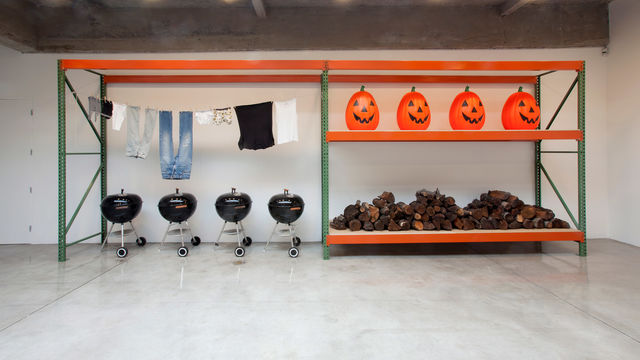
Haim Steinbach
Denim jeans and cotton long johns hang from a clothesline. Plastic jack-o'-lanterns grin atop a shelf. Black Weber grills are arranged in a line as if on sale at the local hardware store or awaiting a cooking contest. All organized within a factory-made shelving unit, the items in Backyard Story (1997) could tell a somewhat conventional tale of the last vestiges of summer creeping into autumn. But the tidy scene is too clinically composed and deliberate to suggest something so quotidian. As in most of Haim Steinbach's works, the elements in Backyard Story play double roles: the shelves act as both an armature and a framing device—simultaneously a display mechanism and part of the artwork—and the individual objects are both what they are (clothing, jack-o'-lanterns, grills, wood) and formal elements in a deliberately articulated composition (blue and soft, orange and slick, black and shiny, brown and rough). Steinbach uses repetition as both a rhythmic compositional strategy and a means to throw viewers off the narrative trail. The title's reference to a "story" can operate as either plot or marketing device. Further, Steinbach confuses the question of context by transposing these readily available objects into the site of an exhibition.
In Steinbach's oddly beautiful, conceptually precise, and disarmingly humorous works, objects behave semiotically, like words or gestures. They are asked to "act" as they must, being what they are, while they are also pressed into newly transparent use for their personal and cultural associations. Steinbach puts one thing next to another in unexpected ways so that we may contemplate the precise attributes of individual objects. Lined up in rows on beautifully constructed custom shelves or tidily scattered about on platforms, his objects (purchased, found, gifted, and borrowed) are always thoughtfully arranged, crafted like words into poems. Indeed, he is also a collector of found words and phrases, which he applies directly onto walls to both delineate and interrupt space. His appropriated text works paint vivid images, some more psychological than others. The eponymous text work in this exhibition reads, "Now you can afford to stop driving each other crazy." One can imagine this as a caption beneath a New Yorker cartoon or as a tagline in an advertisement for a luxury item. Or perhaps it was extracted from some great work of literature. Regardless, Steinbach's gesture of removing the words from one context and placing them in another allows us to think about language not just as a means of communication but as aesthetic and symbolic images (letterforms) or objects (words, phrases, sentences).
When Steinbach gave up painting to make sculpture in 1975, he quickly adopted the form of the shelf as the "structuring device" for his work. "In my parents' home in upstate New York, there was a shelf about ten inches above the kitchen table, which was pushed against the wall. On that shelf was everything from a small calendar to knickknacks and a flower vase. There were also other little objects there, like the figure of an Israeli boy wearing the typical Israeli hat—a kova tembel, which means 'silly hat'—and a napkin holder with a lozenge-shaped piece of wood on it."# In the early 1980s Steinbach visited the homes of several acquaintances, colleagues, and friends to make a series of photographs inspired by the shelf in his childhood home. After installing a small shelf, he made studied arrangements of his friends' belongings. He then photographed the tableaux. The resulting images are like portraits of the objects' owners and, like all Steinbach's subsequent works, demonstrate the descriptive power of stuff.
—Corrina Peipon


